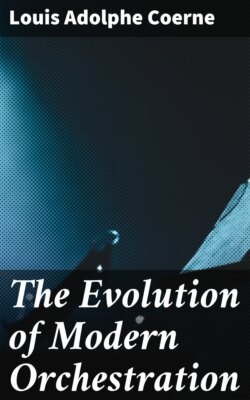Читать книгу The Evolution of Modern Orchestration - Louis Adolphe Coerne - Страница 10
IV.
ОглавлениеContinuing our chronological review, we trace the propagandism of Italian theoretical principles through France into the Netherlands. Here, during the fifteenth and early sixteenth centuries, polyphonic vocal music was reared on the exalted pedestals of noble Gothic architecture. From Dufay—the connecting link between the French and Flemish Schools—through Ockeghem, Josquin des Près, Willaert, to Lasso, the supremacy of musical composition was conceded to the Low Countries, although simultaneous musical activity in Italy was by no means retrogressional. As for the labors of such men as Dunstable in England and Isaak in Germany, the former was not in the direct line either of technical or of æsthetic evolution, whereas the latter was trained in Italy and wrote in the Flemish style.
The concentrated results of this era consisted of the consecutive development of the technicalities of counterpoint, growing regard for euphony and expressive verbal interpretation, finally, the ascendency of objective emotionalism. Lasso, embodying in his works the highest ideals of polyphonic writing, transplanted them into Germany. Simultaneously, Palestrina, the greatest purist of Italian vocal writing, was at the zenith of his glory. France had produced Goudimel and Claude le Jeune. The music of England was prominently connected with such names as Merbecke, Tallys, Byrd, Morley. The Reformation was exercising a powerful influence upon the art of music in the development of the Chorale.
And thus in the second half of the sixteenth century, this wonderful array of coexisting phases of choral art stood prepared for something greater. Pure choral music had been perfected. The era of instrumental music was at hand. For in spite of the rare æsthetic beauty, the intricate yet lucid voice-leading, the admirable handling of human voices en masse that signalize the works of Palestrina and Lasso, two essential elements, indispensable for further creative expansion, were lacking—rhythm and form. To attain these, new means and methods were necessary. Two possibilities presented themselves: solo singing, and instrumental music. Although both of these combined had been subjected to quasi-scientific experiment since time immemorial, the style of writing for them possessed as yet but little individuality. There was indeed much to be done before a permanent basis for modern tonality and modern instrumentation could be secured. The old modal system was still at the root of both sacred and secular music. Harmony was but the adventitious corollary of counterpoint. Only simple diatonic intervals were in use. Incipient harmony could not inspire men to think rhythmically. Pure church music was monotonous and vague. True, secular music in erudite form was influenced by the Folk-song, and showed some progress in rhythmic and simple harmonic effects. These in turn reacted favorably upon the sacred forms. Nevertheless, any attempt at developing motives as the synthetic germs of a composition was not to be thought of until the following century in connection with instrumental forms.
The pith of the conditions prevalent at the close of the era has been happily stated by Parry when he says: "It is as though the art was still in too nebulous a state for the essential elements to have crystallized into separate and definite entities."
